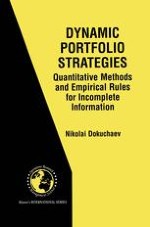Dynamic Portfolio Strategies: Quantitative Methods and Empirical Rules for Incomplete Information investigates optimal investment problems for stochastic financial market models. It is addressed to academics and students who are interested in the mathematics of finance, stochastic processes, and optimal control, and also to practitioners in risk management and quantitative analysis who are interested in new strategies and methods of stochastic analysis.
While there are many works devoted to the solution of optimal investment problems for various models, the focus of this book is on analytical strategies based on "technical analysis" which are model-free. The technical analysis of these strategies has a number of characteristics. Two of the more important characteristics are: (1) they require only historical data, and (2) typically they are more widely used by traders than analysis based on stochastic models. Hence it is the objective of this book to reduce the gap between model-free strategies and strategies that are "optimal" for stochastic models. We hope that researchers, students and practitioners will be interested in some of the new empirically based methods of "technical analysis" strategies suggested in this book and evaluated via stochastic market models.
